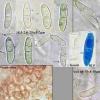
20-12-2025 15:47
Mirek GrycHi.These grew on pine wood that was heavily covere

18-12-2025 21:17
Pol DebaenstThe identification took me to Byssonectria deformi

15-12-2025 07:09
 Danny Newman
Danny Newman
indet. Rutstroemiaceae sp. on unk. fallen leavesMc

19-12-2025 10:10
Patrice TANCHAUDBonjour, récolte réalisée en milieu dunaire, a

18-12-2025 17:23
 Bruno Coué
Bruno Coué
Bonjour,je serais heureux d'avoir votre avis sur c

18-12-2025 18:07
Margot en Geert VullingsThese plumes were found on rotten wood.They strong

17-12-2025 18:35
 Michel Hairaud
Michel Hairaud
Bonjour à tous/Hi to everyone I am passing along

15-12-2025 15:48
 Danny Newman
Danny Newman
Melanospora cf. lagenaria on old, rotting, fallen
Nectria on Frangula alnus
Björn Wergen,
27-07-2011 13:59
 Hi,
Hi,yesterday I have found a new Nectria on dead Frangula-twigs. It has very large spores with a length sometimes over 25 µm. The fruitbodies are clustered on a Stroma which seems not to be well developed, perithecia are about 0,2-0,4 mm and pale red to orange-red oder orange-brown.
The interesting fact is, that the asci have almost only 4 or 6 spores. I didn't see any asci with 8 spores. Spore ornamentation seems to be smooth, without striae. I will add some photos here, perhaps someone can help me with this or at least with a good nectria-key (I have only one key with striae-spored nectria...)
best regards,
kazuya
Björn Wergen,
27-07-2011 15:01

Re : Nectria on Frangula alnus
note: I think the small spores are "secondary spores", aren't they? I had called them "conidia spores"...
Christian Lechat,
27-07-2011 20:37

Re : Nectria on Frangula alnus
Dear Kazuya,
could you please make a vertical section through ascomatal wall and stroma?
Conidia looks like Tubercularia.
Christian
could you please make a vertical section through ascomatal wall and stroma?
Conidia looks like Tubercularia.
Christian


